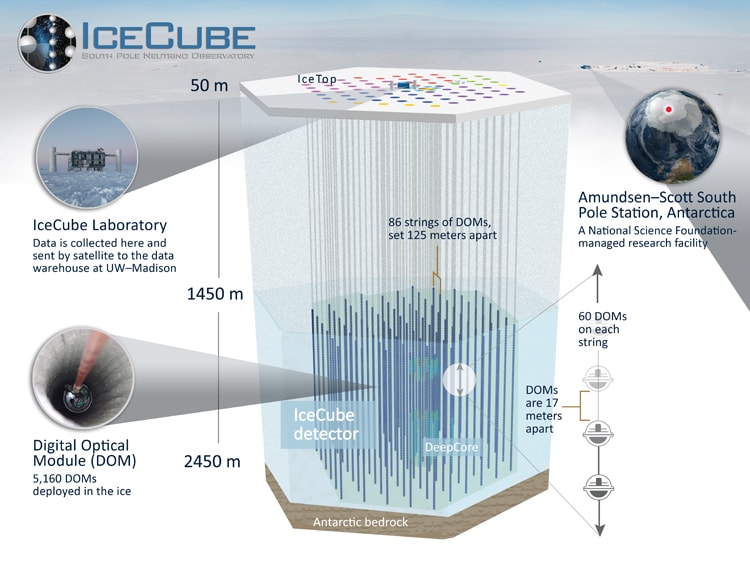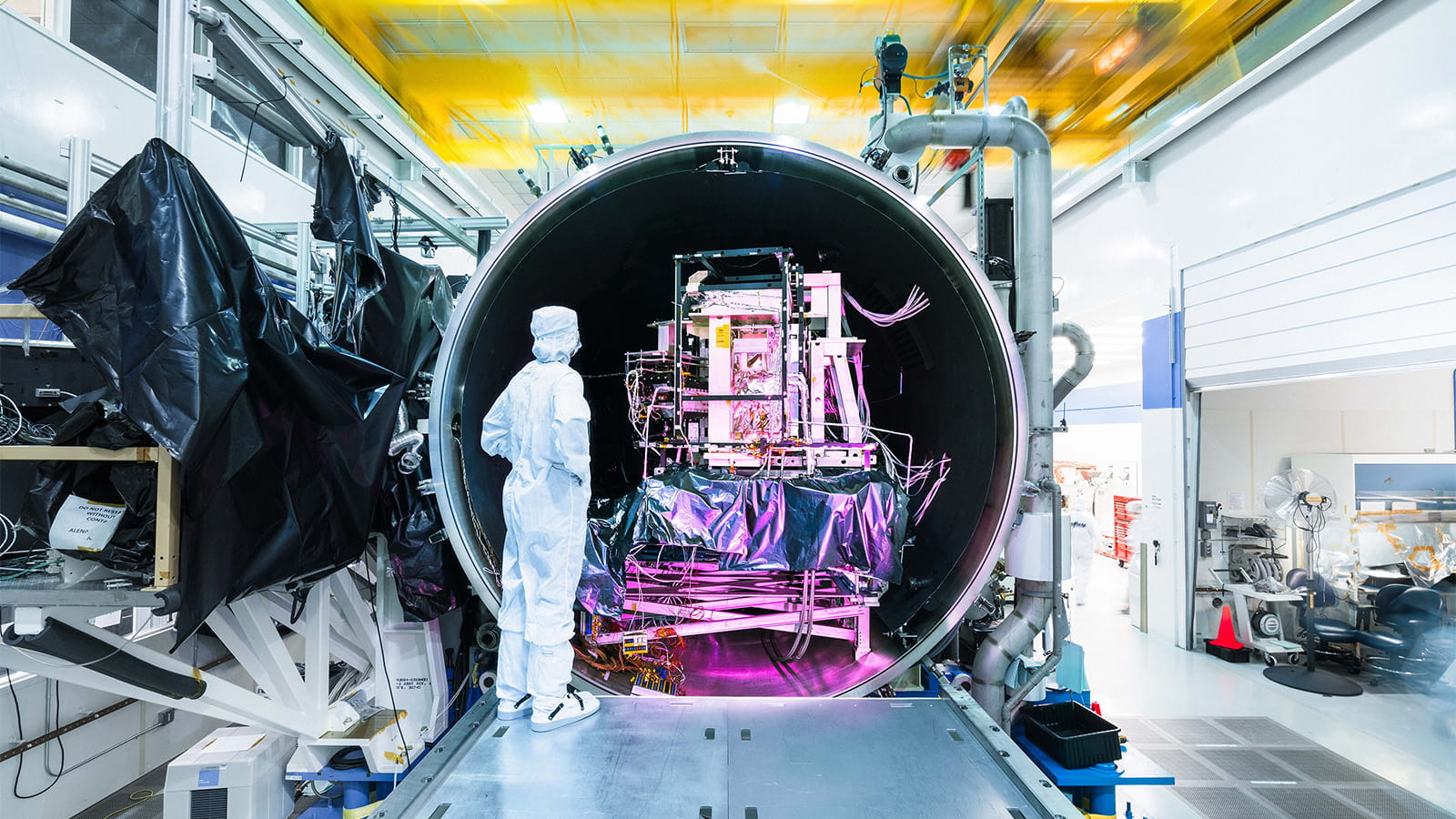by Brian Shilhavy, Health Impact News:

The IceCube Neutrino Observatory is located at the South Pole, which searches for subatomic particles called “neutrinos.” It is operated by an international group of scientists, comprising of approximately 300 physicists from 58 institutions in 14 countries called the IceCube Collaboration.
The IceCube Neutrino Observatory is the first detector of its kind, designed to observe the cosmos from deep within the South Pole ice. An international group of scientists responsible for the scientific research makes up the IceCube Collaboration.
TRUTH LIVES on at https://sgtreport.tv/

Encompassing a cubic kilometer of ice, IceCube searches for nearly massless subatomic particles called neutrinos. These high-energy astronomical messengers provide information to probe the most violent astrophysical sources: events like exploding stars, gamma-ray bursts, and cataclysmic phenomena involving black holes and neutron stars.
The Antarctic neutrino observatory, which also includes the surface array IceTop and the dense infill array DeepCore, was designed as a multipurpose experiment. IceCube collaborators address several big questions in physics, like the nature of dark matter and the properties of the neutrino itself. IceCube also observes cosmic rays that interact with the Earth’s atmosphere, which have revealed fascinating structures that are not presently understood.
Approximately 300 physicists from 58 institutions in 14 countries make up the IceCube Collaboration. The international team is responsible for the scientific program, and many of the collaborators contributed to the design and construction of the detector. Exciting new research conducted by the collaboration is opening a new window for exploring our universe.
The National Science Foundation (NSF) provided the primary funding for the IceCube Neutrino Observatory, with assistance from partner funding agencies around the world. The University of Wisconsin–Madison is the lead institution, responsible for the maintenance and operations of the detector. Funding Agencies in each collaborating country support their scientific research efforts. (Source.)
Funding comes from both government sources, mainly through universities, as well as the private sector. The website is sponsored by the University of Wisconsin.
IceCube is a cubic-kilometer particle detector made of Antarctic ice and located near the Amundsen-Scott South Pole Station. It is buried beneath the surface, extending to a depth of about 2,500 meters.
IceCube, the South Pole neutrino observatory, is a cubic-kilometer particle detector made of Antarctic ice and located near the Amundsen-Scott South Pole Station. It is buried beneath the surface, extending to a depth of about 2,500 meters. A surface array, IceTop, and a denser inner subdetector, DeepCore, significantly enhance the capabilities of the observatory, making it a multipurpose facility.
IceCube is the first gigaton neutrino detector ever built and was primarily designed to observe neutrinos from the most violent astrophysical sources in our universe. Neutrinos, almost massless particles with no electric charge, can travel from their sources to Earth with essentially no attenuation and no deflection by magnetic fields.
The in-ice component of IceCube consists of 5,160 digital optical modules (DOMs), each with a ten-inch photomultiplier tube and associated electronics. The DOMs are attached to vertical “strings,” frozen into 86 boreholes, and arrayed over a cubic kilometer from 1,450 meters to 2,450 meters depth. The strings are deployed on a hexagonal grid with 125 meters spacing and hold 60 DOMs each. The vertical separation of the DOMs is 17 meters.
Eight of these strings at the center of the array were deployed more compactly, with a horizontal separation of about 70 meters and a vertical DOM spacing of 7 meters. This denser configuration forms the DeepCore subdetector, which lowers the neutrino energy threshold to about 10 GeV, creating the opportunity to study neutrino oscillations.
IceTop consists of 81 stations located on top of the same number of IceCube strings. Each station has two tanks, each equipped with two downward facing DOMs. IceTop, built as a veto and calibration detector for IceCube, also detects air showers from primary cosmic rays in the 300 TeV to 1 EeV energy range. The surface array measures the cosmic-ray arrival directions in the Southern Hemisphere as well as the flux and composition of cosmic rays.
Developments in neutrino astronomy have been driven by the search for the sources of cosmic rays, leading at an early stage to the concept of a cubic-kilometer neutrino detector. Cosmic rays, which consist mainly of protons, are the highest energy particles ever observed, with energies over a million times those reached by today’s particle accelerators on Earth.
AMANDA, the Antarctic Muon and Neutrino Detector Array, was built as a proof of concept in the mid 1990s and demonstrated that the extremely clear Antarctic ice was suitable for detecting energetic neutrinos. IceCube, the only cubic-kilometer neutrino detector constructed to date, was completed in December 2010, only six years after the deployment of the first string at the South Pole. (Source.)
A whistleblower who worked at IceCube for about a year has gone public with warnings about alleged technology associated with IceCube, claiming that they have developed energy weapons that can cause earthquakes.
He was a contractor for Raytheon, one of the largest corporations in the world that develops weapons for the military.
How do you develop the technology that will transform aerospace and defense?
You start with 59,000 engineers, 60,000 patents, $7.1 billion in annual research and development funding, and 13 technology roadmaps that reflect what our customers will need, well into the future.
Then you add a venture capital division that invests in companies trying bold new concepts in areas such as artificial intelligence and electrified propulsion, and you complement it with research involving more than 80 U.S. universities.
This is our formula for transformative technologies – the products, systems and concepts to help our customers meet their most critical needs, as well as those they have yet to envision. (Source.)
On the Raytheon Technologies website, they have a section explaining how they develop “transformative technologies”, and one of those technologies is “Advanced sensing”.

We have a deep heritage in developing radio frequency, electro-optical/infrared sensing, communications and electronic warfare systems for space, air, ground, sea and undersea environments. (Source.)
Eric J Hecker was reportedly a contractor for Raytheon that spent about a year at the IceCube facility in Antarctica.
His bio:
Currently residing in Alaska, Eric is a self educated research investigator that takes from his many odd life experiences and connects with others.
Eric was raised on Long Island the home of the now famous Montauk Project. His childhood included being part of the Stargate Project run by the CIA/DIA. Later on he had experiences in the Submarine Service. Following that he became a plumber for some of the wealthiest people in the world back on Long Island. In 2010 Eric took a contract to work at the South Pole Station for a year.
Always the avid researcher, it was not until Eric began working remotely throughout the State of Alaska that he started making connections that his own life may not have been what he thought it was. (Source.)
Greg Reese published a report this week about Hecker’s claims as a whistleblower and that an energy weapon exists that can cause earthquakes.
Read More @ HealthImpactNews.com



